A Review on Solar Panel Cleaning Systems and Techniques
Abstract
:1. Introduction
2. Deposits and Their Effects
2.1. The Impact of Dust on Solar Panel Production
2.2. The Impact of Bird Debris and Tree Foliage on Solar Panel Production
2.2.1. Series Configuration
2.2.2. Parallel Configuration
- The current from C2 is not affected by shading on C1.
- The current from D1 is not affected by shading on C1.
- The total system current is the sum of the currents from C2 and D1. Bypass diodes allow current to bypass C1 and D1.
- Current production from C2 and D2 is not as affected by shading on C1 and D1.
2.3. The Concentration and Type of Deposits Depend on the Region

2.4. Influence of Seasonal Effecton Dust Accumulation
3. Solar Panel Cleaning Systems
3.1. Manual Cleaning
3.2. Water Spray Nozzle Systems
3.3. Truck-Mounted Cleaning
3.4. The Electrodynamic Screen (EDS)
3.5. The “Wash Panel” Cleaning Robot
3.6. Aerial Cleaning by Drones
- Key Components for Solar Panel Cleaning Using Drones:
- Optimizing Drone Trajectories for Precise and Efficient Solar Panel Cleaning:
- Influence of Drone Flight Patterns on Solar Panel Energy Production Efficiency Across Dust Levels:
3.7. The Resola Robot by Sinfonia
3.8. Self-Cleaning and Tracking Solar Photovoltaic Panels
4. Desirable and Undesirable Features for Solar Panel Cleaning Methods
5. Cost–Benefit Analysis
6. Conclusions
Author Contributions
Funding
Conflicts of Interest
References
- Connaissance des Énergies. Available online: https://www.connaissancedesenergies.org/levolution-du-mix-electrique-mondial-en-2022-en-2-infographies-230413 (accessed on 12 August 2023).
- France Territoire Solaire. Available online: https://franceterritoiresolaire.fr/developper-le-solaire-permet-il-vraiment-de-diminuer-les-emissions-de-co2/ (accessed on 12 August 2023).
- Darwish, Z.A.; Kazem, H.A.; Sopian, K.; Al-Goul, M.A.; Alawadhi, H. Effect of dust pollutant type on photovoltaic performance. Renew. Sustain. Energy Rev. 2014, 41, 735–744. [Google Scholar] [CrossRef]
- Gochhait, S.; Asodiya, R.; Hasarmani, T.; Patin, V.; Maslova, O. Application of IoT: A Study on Automated Solar Panel Cleaning System. In Proceedings of the 4th International Conference on Electrical, Control and Instrumentation Engineering (ICECIE), Kuala Lumpur, Malaysia, 26 November 2022. [Google Scholar] [CrossRef]
- Said, S.A.; Walwil, H.M. Fundamental studies on dust fouling effects on PV module performance. Sol. Energy 2014, 107, 328–337. [Google Scholar] [CrossRef]
- Myyas, R.N.; Al-Dabbasa, M.; Tostado-Véliz, M.; Jurado, F. A novel solar panel cleaning mechanism to improve performance and harvesting rainwater. Sol. Energy 2022, 237, 19–28. [Google Scholar] [CrossRef]
- Tilmatine, A.; Kadous, N.; Yanallah, K.; Bellebna, Y.; Bendaoudi, Z.; Zouaghi, A. Experimental investigation of a new solar panels cleaning system using ionic wind produced by corona discharge. J. Electrost. 2023, 124, 103827. [Google Scholar] [CrossRef]
- Nomeir, B.; Lakhouil, S.; Boukheir, S.; Ali, M.A.; Naamane, S. Recent progress on transparent and self-cleaning surfaces by superhydrophobic coatings deposition to optimize the cleaning process of solar panels. Sol. Energy Mater. Sol. Cells 2023, 257, 112347. [Google Scholar] [CrossRef]
- Ma, J.; Youn, J.-H.; Cho, H.; Park, J.; Kyung, K.-U. Highly efficient long-lasting triboelectric nanogenerator upon impact and its application to daily-life self-cleaning solar panel. Nano Energy 2022, 103, 107836. [Google Scholar] [CrossRef]
- Seifi, A.; Salari, D.; Khataee, A.; Çoşut, B.; Arslan, L.; Niaei, A. Enhanced photocatalytic activity of highly transparent superhydrophilic doped TiO2 thin films for improving the self-cleaning property of solar panel covers. Ceram. Int. 2023, 49, 1678–1689. [Google Scholar] [CrossRef]
- Jaiganesh, K.; Reddy, K.B.S.; Shobhitha, B.; Goud, B.D. Enhancing the efficiency of rooftop solar photovoltaic panel with simple cleaning mechanism. Mater. Today Proc. 2021, 51, 411–415. [Google Scholar] [CrossRef]
- Kawamoto, H.; Tanabe, J.; Kobayashi, Y. Airflow-assisted electrodynamic cleaning of sand deposited on solar panels. J. Electrost. 2021, 113, 103618. [Google Scholar] [CrossRef]
- Derakhshandeh, J.F.; AlLuqman, R.; Mohammad, S.; AlHussain, H.; AlHendi, G.; AlEid, D.; Ahmad, Z. A comprehensive review of automatic cleaning systems of solar panels. Sustain. Energy Technol. Assess. 2021, 47, 101518. [Google Scholar] [CrossRef]
- Ko, K.; Yoon, D.; Yang, S.C.; Lee, H.S. Brush-painted superhydrophobic silica coating layers for self-cleaning solar panels. J. Ind. Eng. Chem. 2021, 106, 460–468. [Google Scholar] [CrossRef]
- Li, D.; King, M.; Dooner, M.; Guo, S.; Wang, J. Study on the cleaning and cooling of solar photovoltaic panels using compressed airflow. Sol. Energy 2021, 221, 433–444. [Google Scholar] [CrossRef]
- Divya Vidya, K.; Abirami, S.; Jaganayaki, S.; Jayanthi, A.N. Solar panel cleaning robot. Int. J. Sci. Res. Eng. Manag. 2023. [Google Scholar] [CrossRef]
- Venkatnikhil, A.; Ravichandran, S.; Kumar, N.K.H. Rover Robot for Solar Panel Cleaning and Monitoring. In Proceedings of the IEEE North Karnataka Subsection Flagship International Conference (NKCon), Vijaypur, India, 20–21 November 2022. [Google Scholar] [CrossRef]
- Muhammad, A.B. Automatic Solar Panel Cleaning Benefits. Gobal J. Res. Eng. Comput. Sci. 2023, 3, 26–31. [Google Scholar]
- Jothi Venkatesh, K.; SankaraNarayanan, S.; Kannan, K.; Arjun, P. AI Based Solar Panel Cleaning Robot. Int. J. Eng. Technol. Manag. Sci. 2023, 7, 313–318. [Google Scholar] [CrossRef]
- Baballe, M.A. Review of the Literature on Robotic Solar Panel Cleaning. Glob. J. Res. Eng. Comput. Sci. 2023, 3, 21–25. [Google Scholar] [CrossRef]
- Omar, M.; Arif, A.; Usman, M.; Khan, S.S.; Larkin, S. Self-cleaning solution for solar panels. SAIEE Afr. Res. J. 2023, 114, 58–66. [Google Scholar] [CrossRef]
- Tripathi, A.K.; Aruna, M.; Ray, S.; Rao, N.G.; Vamshni Krishna, S.; Nandan, D. Development and Evaluation of Dust Cleaning System for a Solar PV Panel. J. Eng. Res. 2022. [Google Scholar] [CrossRef]
- Deb, D.; Bhargava, K. Water-free automated solar-panel cleaning. In Degradation, Mitigation, and Forecasting Approaches in Thin Film Photovoltaics; Elsevier: Amsterdam, The Netherlands, 2022; pp. 73–84. [Google Scholar]
- Maghami, M.R.; Hizam, H.; Gomes, C.; Radzi, M.A.; Rezadad, M.I.; Hajighorbani, S. Power loss due to soiling on solar panel: A review. Renew. Sustain. Energy Rev. 2016, 59, 1307–1316. [Google Scholar] [CrossRef]
- Nahoui, A.; Haddad, Z.; Tahrour, F. Etude Expérimentale de L’effet de la Poussière et de Fientes des Oiseaux sur le Fonctionnement des Panneaux Solaires Photovoltaïques pour le Site de M’sila. Master’s Thesis, Université Mohamed Boudiaf, M’sila, Algérie, 2022. [Google Scholar]
- SciencePost. Available online: https://sciencepost.fr/depoussierer-panneaux-solaires-economies/ (accessed on 12 August 2023).
- Saidan, M.; Albaali, A.G.; Alasis, E.; Kaldellis, J.K. Experimental study on the effect of dust deposition on solar photovoltaic panels in desert environment. Renew. Energy 2016, 92, 499–505. [Google Scholar] [CrossRef]
- Majeed, R.; Waqas, A.; Sami, H.; Ali, M.; Shahzad, N. Experimental investigation of soiling losses and a novel cost-effective cleaning system for PV modules. Sol. Energy 2020, 201, 298–306. [Google Scholar] [CrossRef]
- Blog Seatronic. Available online: http://blog.seatronic.fr/fiches-pratiques/energie/production/panneaux-solaires/regulateur/ (accessed on 12 August 2023).
- LinkedIn. Available online: https://www.linkedin.com/pulse/how-protect-your-solar-from-bird-poo-climateshield-solar/ (accessed on 12 August 2023).
- Kazem, H.A.; Chaichan, M.T. The effect of dust accumulation and cleaning methods on PV panels’ outcomes based on an experimental study of six locations in Northern Oman. Sol. Energy 2019, 187, 30–38. [Google Scholar] [CrossRef]
- Nour-Eddine, I.O.; Lahcen, B.; Fahd, O.H.; Amin, B.; Aziz, O. Outdoor performance analysis of different PV technologies under hot semi-arid climate. Energy Rep. 2020, 6, 36–48. [Google Scholar] [CrossRef]
- Costa, S.C.; Diniz, A.S.A.; Kazmerski, L.L. Dust and soiling issues and impacts relating to solar energy systems: Literature review update for 2012–2015. Renew. Sustain. Energy Rev. 2016, 63, 33–61. [Google Scholar] [CrossRef]
- Menoufi, K. Dust Accumulation on the Surface of Photovoltaic Panels: Introducing the Photovoltaic Soiling Index (PVSI). Sustainability 2017, 9, 963. [Google Scholar] [CrossRef]
- Huang, J.; Wang, T.; Wang, W.; Li, Z.; Yan, H. Climate effects of dust aerosols over East Asian arid and semiarid regions. J. Geophys. Res. Atmos. 2014, 119, 11398–11416. [Google Scholar] [CrossRef]
- Grando, M.N.G.N.; Maletz, E.R.; Martins, D.; Simas, H.; Simoni, R. Robots for Cleaning Photovoltaic Panels: State of the Art and Future Prospects. Rev. Tecnol. Cienc. 2019, 35, 137–150. [Google Scholar] [CrossRef]
- Plischke, E. An adaptive correlation ratio method using the cumulative sum of the reordered output. Reliab. Eng. Syst. Saf. 2011, 107, 149–156. [Google Scholar] [CrossRef]
- Eco Green Energy. Available online: https://www.eco-greenenergy.com/fr/comment-tester-un-panneau-solaire-1-salt-mist-test-de-corrosion-saline/ (accessed on 12 August 2023).
- Marathe, S.A.; Patil, B.P. Mechanisms for Improving the Productivity of the Existing Photovoltaic Panels. In Proceedings of the International Conference on Computational Performance Evaluation (ComPE), Hillong, India, 4 July 2020. INSPEC Accession Number: 19986470. [Google Scholar] [CrossRef]
- Ekinci, F.; Yavuzdeğer, A.; Nazlıgül, H.; Esenboğa, B.; Mert, B.D.; Demirdelen, T. Experimental investigation on solar PV panel dust cleaning with solution method. Sol. Energy 2022, 237, 1–10. [Google Scholar] [CrossRef]
- Saravanan, V.S.; Darvekar, S.K. Solar Photovoltaic Panels Cleaning Methods: A Review. Int. J. Pure Appl. Math. 2018, 118, 1–17. [Google Scholar]
- Cano, J.; Tamizhmani, G.; Macia, N.F. Photovoltaic Modules: Effect of Tilt Angle on Soiling; Arizona State University: Tempe, AZ, USA, 2011. [Google Scholar] [CrossRef]
- Gupta, V.; Sharma, M.; Pachauri, R.; Babu, K.N.D. Design and development of self-cleaning PV sliding system. Clean Energy 2022, 6, 392–403. [Google Scholar] [CrossRef]
- Alshehri, A.; Parrott, B.; Outa, A.; Amer, A.; Abdellatif, F.; Trigui, H.; Carrasco, P. Dust mitigation in the desert: Cleaning mechanisms for solar panels in arid regions. In Proceedings of the Saudi Arabia Smart Grid Conference (SASG), Jeddah, Saudi Arabia, 14–17 December 2014. [Google Scholar] [CrossRef]
- Patil, P.A.; Bagi, J.S.; Wagh, M.M. A review on cleaning mechanism of solar photovoltaic panel. In Proceedings of the International Conference on Energy, Communication, Data Analytics and Soft Computing (ICECDS), Chennai, India, 1–2 August 2017. [Google Scholar] [CrossRef]
- ESI Africa. Available online: https://www.esi-africa.com/energy-efficiency/how-to-clean-your-pv-solar-panels/ (accessed on 12 August 2023).
- Alghamdi, A.S.; Bahaj, A.B.S.; Blunden, L.S.; Wu, Y. Dépoussiérage des modules solaires photovoltaïques par des systèmes de nettoyage automatisés. Energies 2019, 12, 2923. [Google Scholar] [CrossRef]
- Ferretti, N. PV Module Cleaning Market Overview and Basics; PI Photovoltaik-Institut Berlin AG: Berlin, Germany, 2018. [Google Scholar]
- Bernard, A.R.; Eriksen, R.; Horenstein, M.N.; Mazumder, M.K. Dust Settles, We Don’t: The Electrodynamic Screen—A Self-Cleaning Technology for Concentrated Solar Power Mirrors and Photovoltaic Panels; Cambridge University Press: Cambridge, UK, 2018; Volume 5. [Google Scholar]
- Chailoet, K.; Pengwang, E. Assembly of Modular Robot for Cleaning Various Length of Solar Panels. IOP Conf. Ser. Mater. Sci. Eng. 2019, 639, 012014. [Google Scholar] [CrossRef]
- Rehman, S.; Mohandes, M.A.; Hussein, A.E.; Alhems, L.M.; Al-Shaikhi, A. Cleaning of Photovoltaic Panels Utilizing the Downward Thrust of a Drone. Energies 2022, 15, 8159. [Google Scholar] [CrossRef]
- Renewable Energy World. Available online: https://www.renewableenergyworld.com/om/from-module-cleaning-robots-to-flying-drones-japans-growing-solar-o-m-market/#gref (accessed on 12 August 2023).
- Bandam, A.; Panchal, A.K. Self-cleaning and tracking solar photovoltaic panel for improving efficiency. In Proceedings of the 2nd International Conference on Advances in Electrical, Electronics, Information, Communication and Bio-Informatics (AEEICB), Chennai, India, 28 February 2016. [Google Scholar] [CrossRef]
- Mardani, A.; Zavadskas, E.K.; Khalifah, Z.; Zakuan, N.; Jusoh, A.; Nor, K.M.; Khoshnoudi, M. A review of multi-criteria decision-making applications to solve energy management problems: Two decades from 1995 to 2015. Renew. Sustain. Energy Rev. 2017, 71, 216–256. [Google Scholar] [CrossRef]
- Mastrocinque, E.; Ramírez, F.J.; Honrubia-Escribano, A.; Pham, D.T. An AHP-based multi-criteria model for sustainable supply chain development in the renewable energy sector. Expert Syst. Appl. 2020, 150, 113321. [Google Scholar] [CrossRef]
- Wang, J.-J.; Jing, Y.-Y.; Zhang, C.-F.; Zhao, J.-H. Review on multi-criteria decision analysis aid in sustainable energy decision-making. Renew. Sustain. Energy Rev. 2009, 13, 2263–2278. [Google Scholar] [CrossRef]
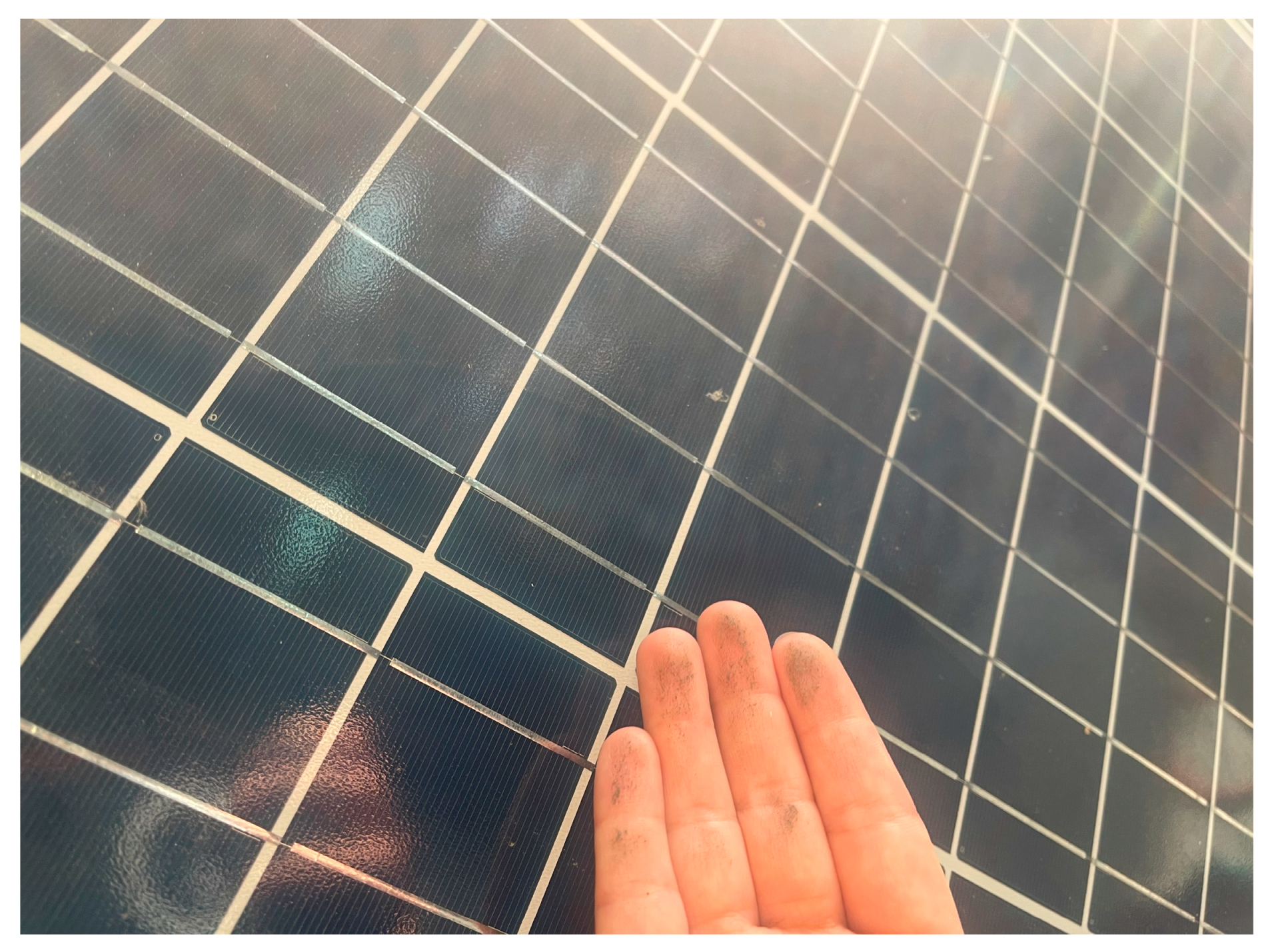
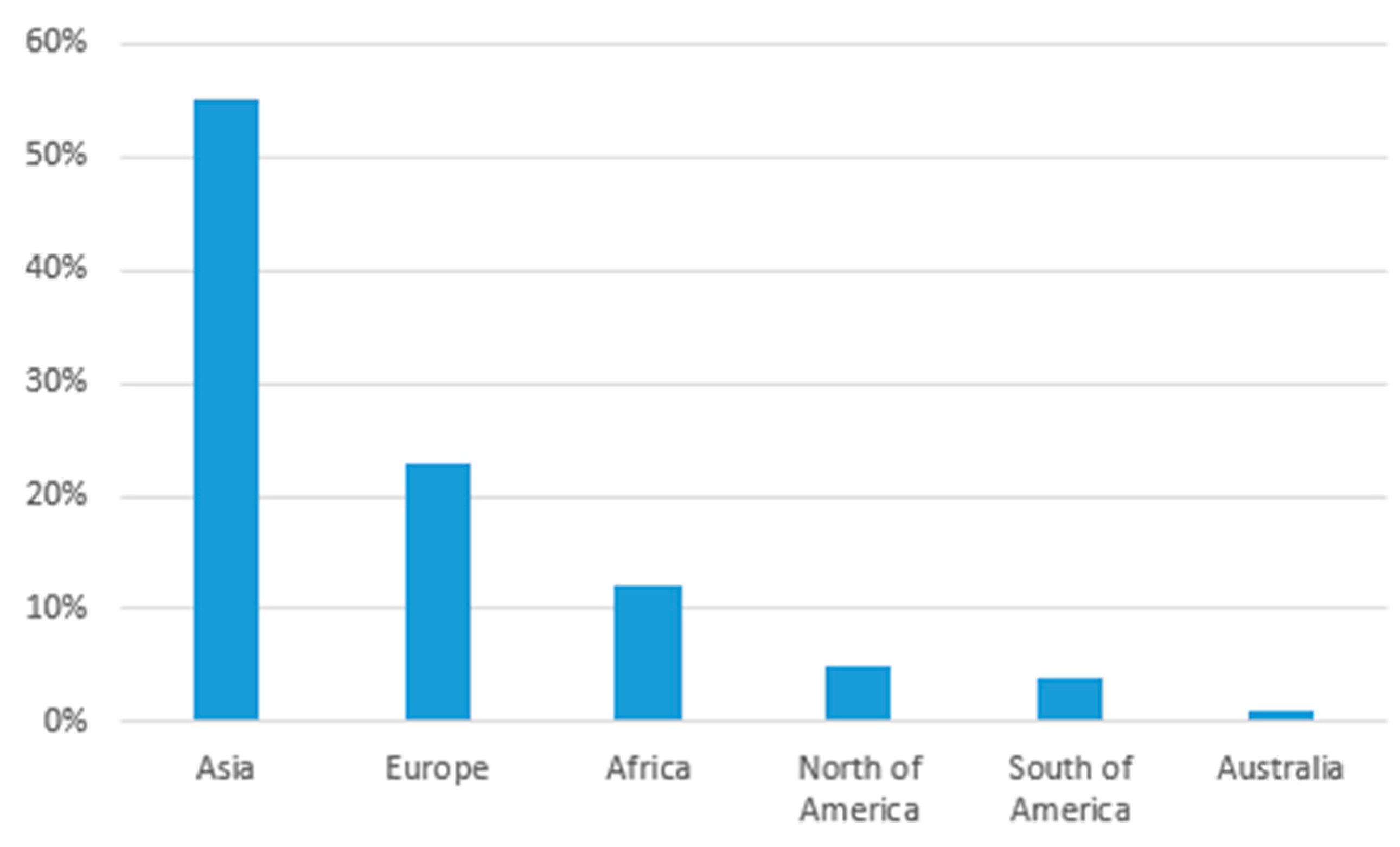
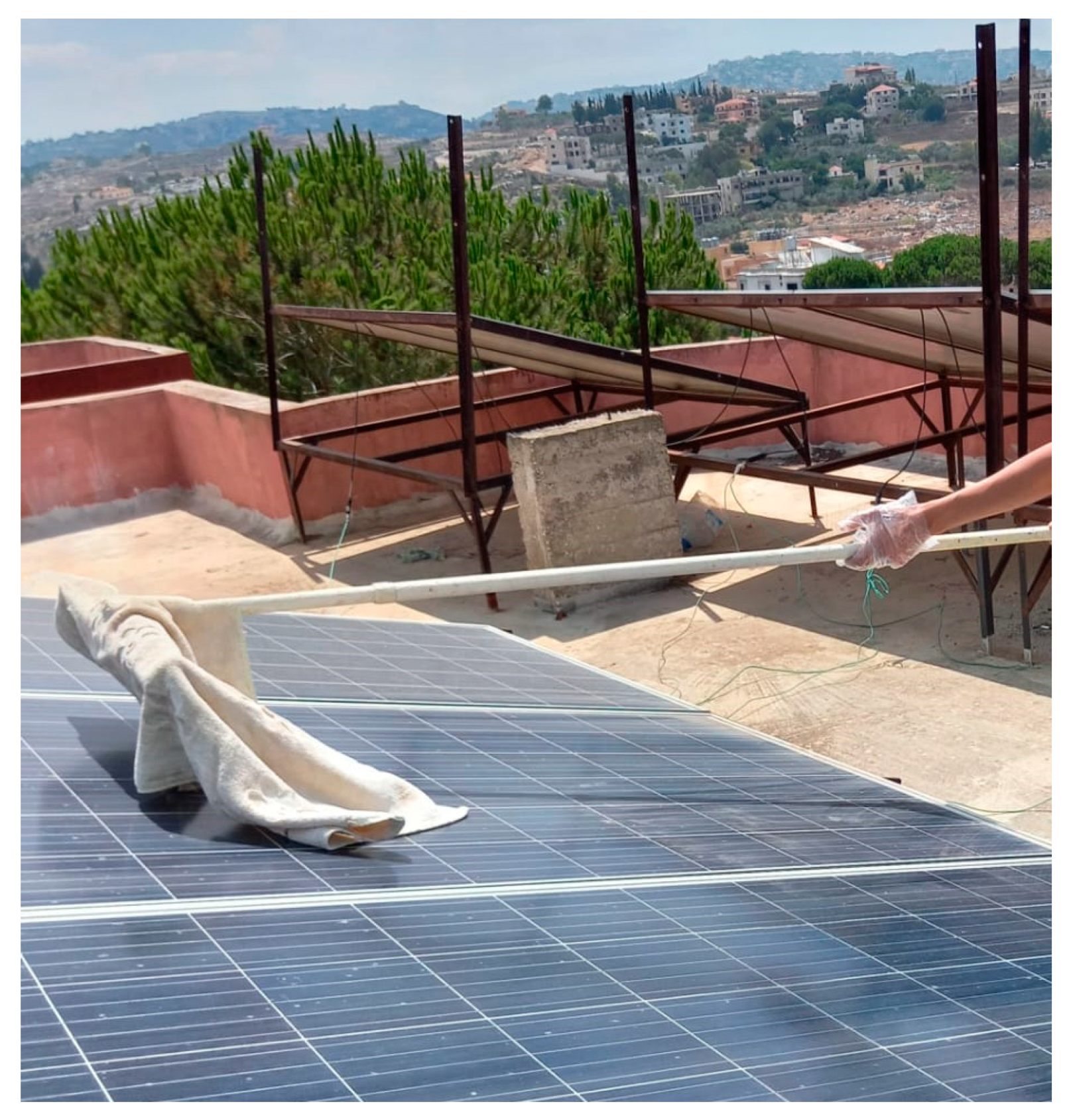
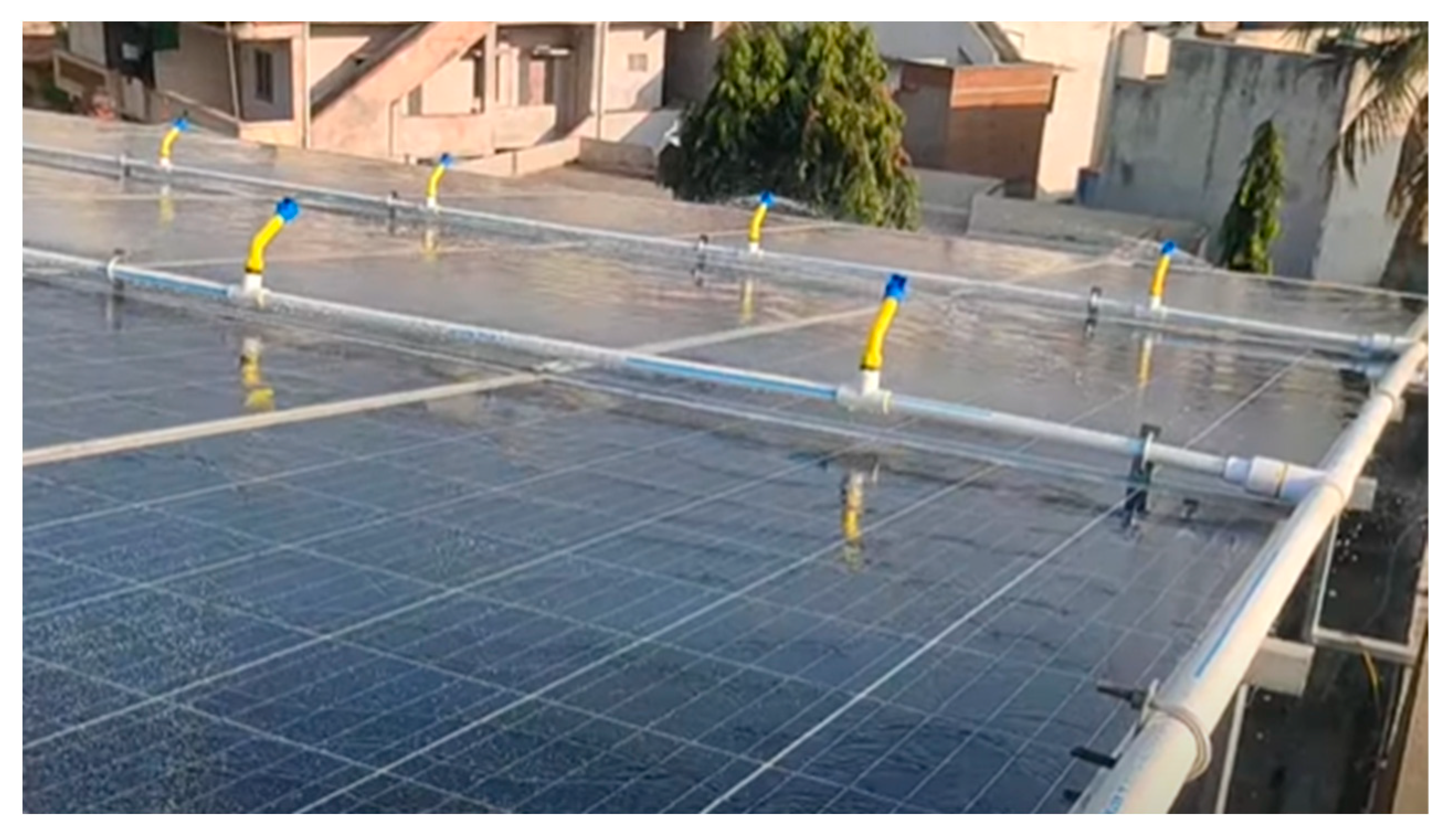
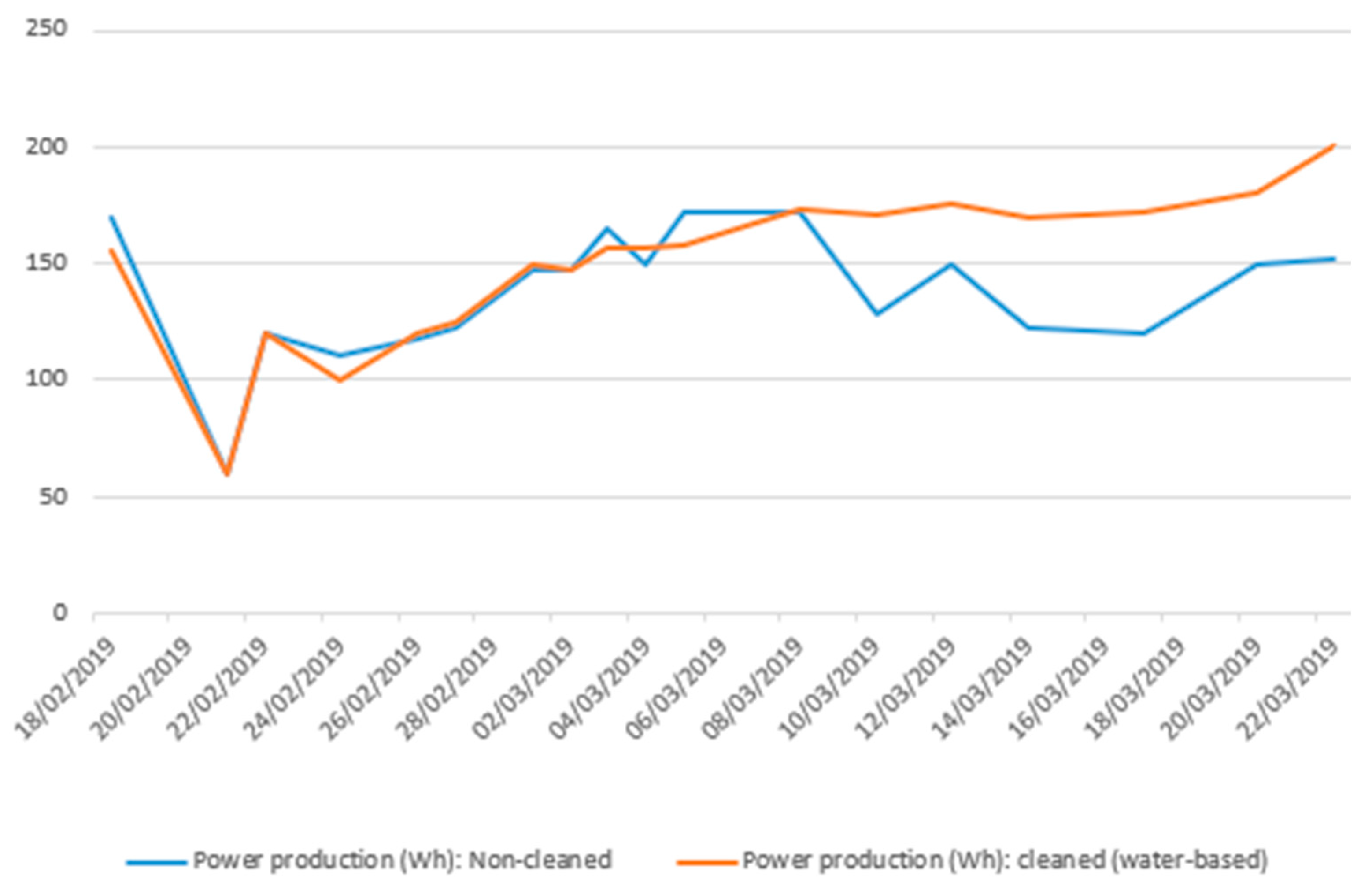

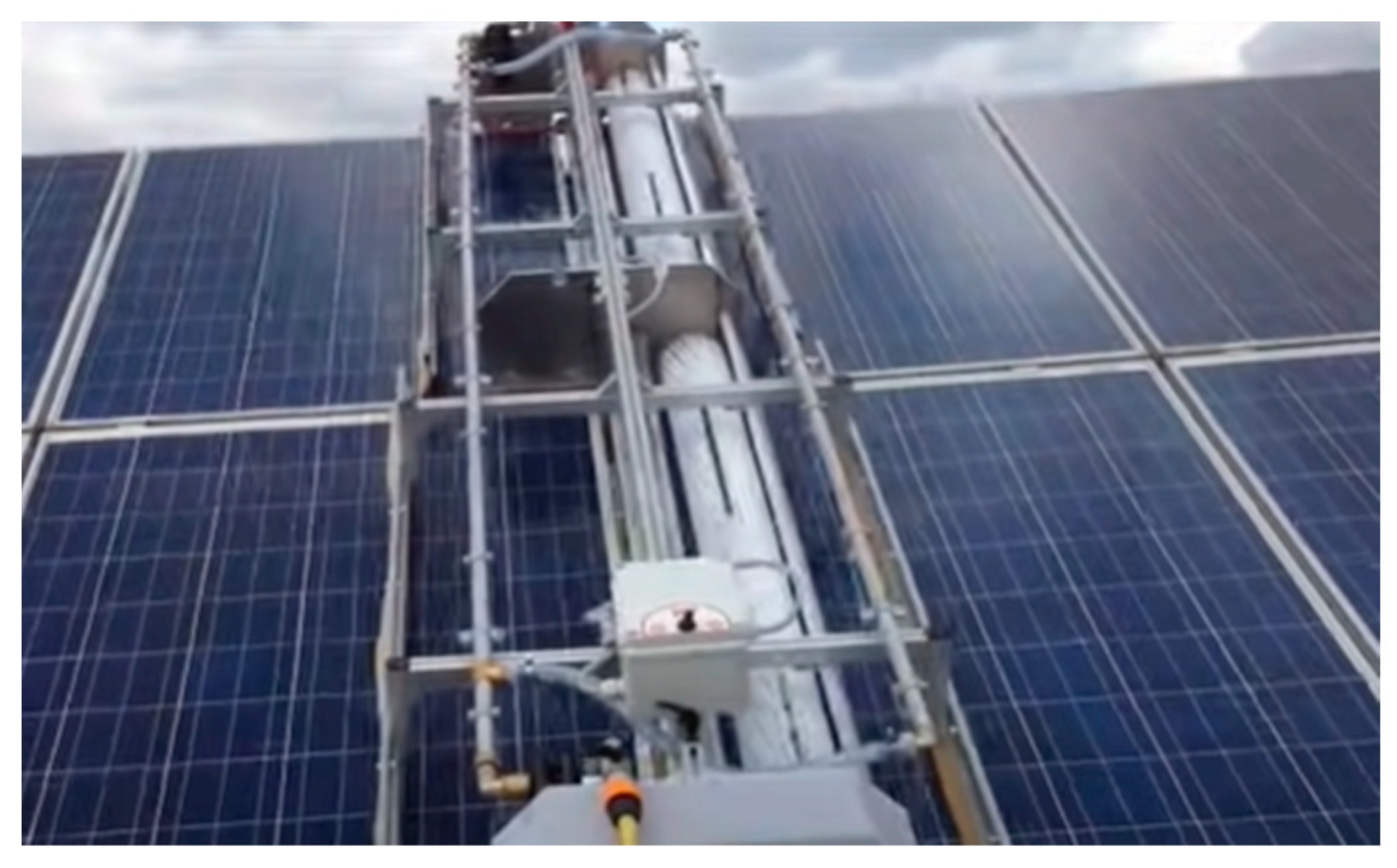
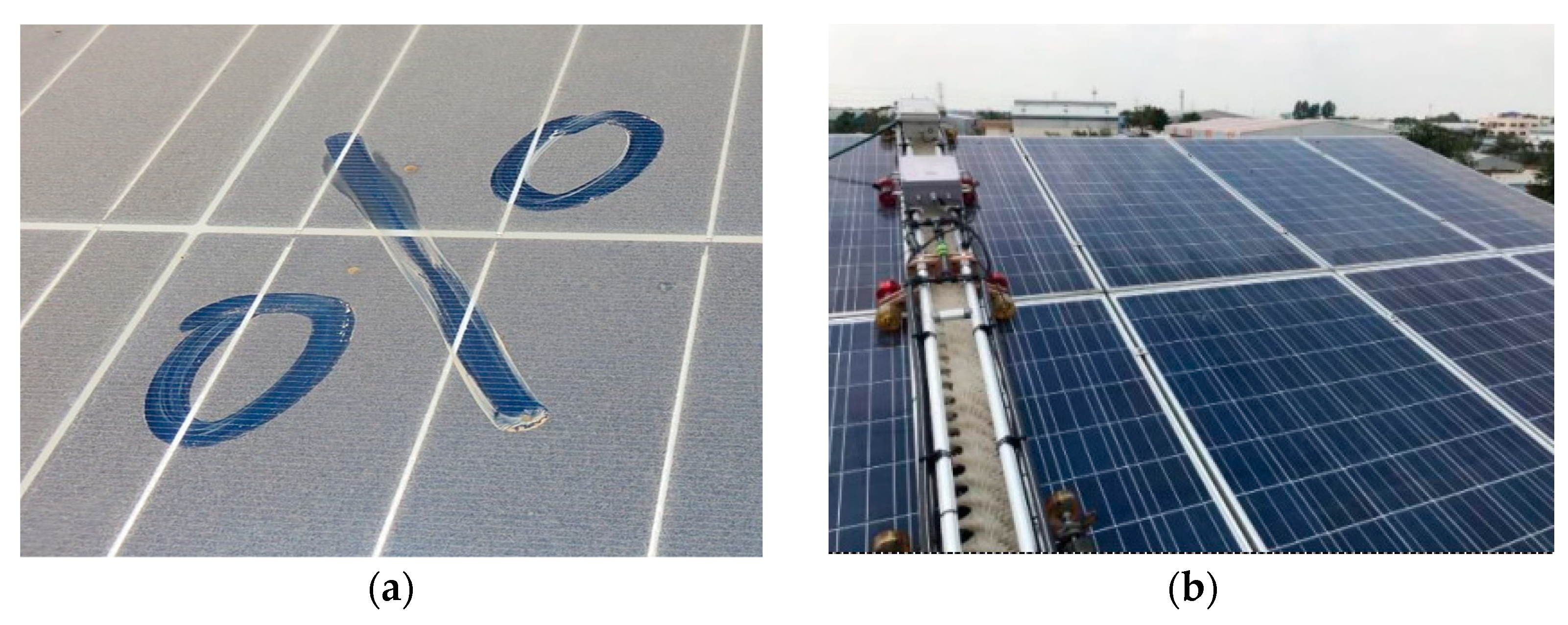

| Dust density (g/m2) | 2 | 4 | 6 | 8 | 10 |
| Output power loss (%) | 8 | 13 | 20 | 28 | 38 |
| Tilt Angle (°) | 0 | 5 | 10 | 20 | 23 | 30 | 33 | 44 |
| Soiling loss (%) | 2.02 | 1.34 | 1.17 | 0.99 | 1.05 | 0.83 | 0.96 | 0.69 |
| Normalized clean/unclean panel efficiency | 01/03/2021 | 19/03/2021 | 02/04/2021 | 26/04/2021 |
| Normalized clean panel efficiency | 0.73% | 0.71% | 0.70% | 0.73% |
| Normalized unclean panel efficiency | 0.73% | 0.68% | 0.60% | 0.59% |
| Total Generated Current | Without Cleaning | For Robot Cleaning |
|---|---|---|
| Total generated current per day in 12/03/2019 (Before cleaning date) | 1113.8 | 1103.03 |
| Total generated current per day in in 15/03/2019 (After cleaning date) | 1094.68 | 1131.86 |
| Features | Desirable | Undesirable |
|---|---|---|
| Efficiency | High cleaning efficiency to maximize energy production | Low cleaning efficiency leading to energy loss |
| Safety | Safe for both the cleaning personnel and the solar panels | Risky methods that could damage panels or harm workers |
| Cost-effectiveness | Affordable to install and operate | Expensive to implement and maintain |
| Water Conservation | Minimal water usage or efficient water recycling | Excessive water consumption |
| Environmental Impact | Environmentally friendly and sustainable | Harmful chemicals or practices |
| Adaptability | Suitable for various panel types, shapes, and sizes | Limited applicability |
| Automation | Automated systems for regular cleaning without human intervention | Manual cleaning that is labor-intensive |
| Maintenance Requirements | Low maintenance systems with minimal downtime | High maintenance systems requiring frequent repairs |
| Cleaning Frequency | Effective for routine cleaning needs | Requires too frequent cleaning |
| Weather Resistance | Works effectively in various weather conditions | Ineffective during extreme weather |
| Durability | Long-lasting and resistant to wear and tear | Prone to damage or degradation |
| Energy Efficiency | Low energy consumption during the cleaning process | High energy usage, which counteracts solar gains |
| Scalability | Can be scaled up or down to accommodate different array sizes | Limited scalability |
| Regulatory Compliance | Meets local regulations and safety standards | Fails to comply |
| Criteria Versus Cleaning Systems | Cleaning Efficiency | Cost | Durability | Environmental Impact | Ease of Use | Overall Score |
|---|---|---|---|---|---|---|
| Manual cleaning | 4 | 3 | 2 | 3 | 4 | 3.2 |
| Water Spray Nozzle Systems | 5 | 2 | 3 | 4 | 3 | 3.4 |
| Truck-mounted cleaning | 3 | 4 | 4 | 2 | 3 | 3.2 |
| Drone Cleaning | 4 | 3 | 3 | 4 | 3 | 3.4 |
| The Electrodynamic Screen (EDS) | 2 | 1 | 3 | 4 | 2 | 2.4 |
| The “Wash Panel” cleaning robot | 4 | 3 | 3 | 3 | 4 | 3.4 |
| Self-Cleaning and Tracking Solar Panels | 3 | 3 | 4 | 4 | 3 | 3.4 |
| The Resola robot by Sinfonia | 4 | 2 | 4 | 4 | 4 | 3.6 |
Disclaimer/Publisher’s Note: The statements, opinions and data contained in all publications are solely those of the individual author(s) and contributor(s) and not of MDPI and/or the editor(s). MDPI and/or the editor(s) disclaim responsibility for any injury to people or property resulting from any ideas, methods, instructions or products referred to in the content. |
© 2023 by the authors. Licensee MDPI, Basel, Switzerland. This article is an open access article distributed under the terms and conditions of the Creative Commons Attribution (CC BY) license (https://creativecommons.org/licenses/by/4.0/).
Share and Cite
Najmi, N.; Rachid, A. A Review on Solar Panel Cleaning Systems and Techniques. Energies 2023, 16, 7960. https://doi.org/10.3390/en16247960
Najmi N, Rachid A. A Review on Solar Panel Cleaning Systems and Techniques. Energies. 2023; 16(24):7960. https://doi.org/10.3390/en16247960
Chicago/Turabian StyleNajmi, Nouhaila, and Ahmed Rachid. 2023. "A Review on Solar Panel Cleaning Systems and Techniques" Energies 16, no. 24: 7960. https://doi.org/10.3390/en16247960
APA StyleNajmi, N., & Rachid, A. (2023). A Review on Solar Panel Cleaning Systems and Techniques. Energies, 16(24), 7960. https://doi.org/10.3390/en16247960







